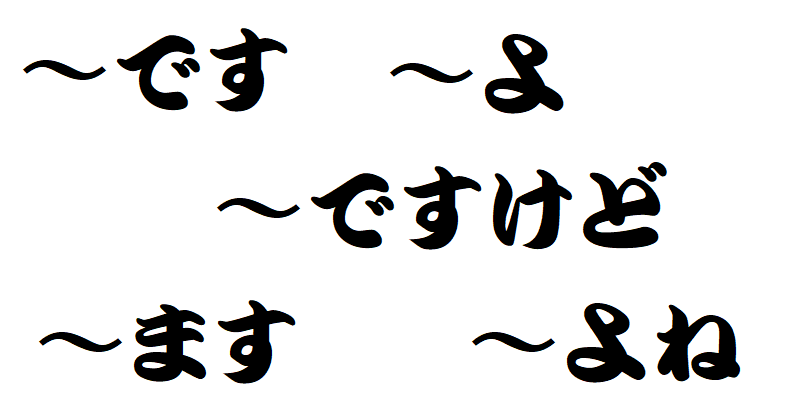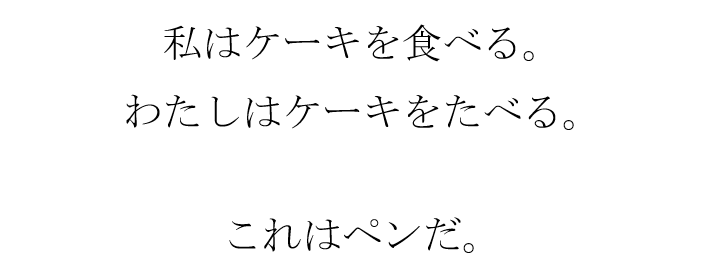6 Common Sentence Endings in Japanese

In this article, we'll introduce you to the six most common sentence endings in Japanese. Some have English equivalents, but some can be a little tricky, as they demand a response from the intended listener without actually asking for it. Feel a little confused? We'll try to clear that up, so that you can converse like a pro!
By Mina Otsuka1. Plain Form

Let's get the most basic one out of the way. A sentence ending in plain form is basically no extra ending added. It's a form that gets the minimally required message through, just enough to make the communication possible.
Watashi wa ke-ki wo taberu
I eat cake.
Kore wa pen da
This is a pen.
If you da after a noun, or you use the dictionary form of a verb, you speak in what’s called jyotai, or direct style in Japanese. It is one of the most basic ways to speak or write, although it comes off a little bare bones or informal.
2. Desu/Masu

Called the desu/masu form or keitai in Japanese, this form is distal style, and the most fundamental formal sentence ending. In rough translation, desu serves as the verb "be" in English, which is added after nouns and adjectives. For example, “I’m a student” in Japanese is watashi wa gakusei desu. Masu, on the other hand, is added to a verb. For example, “I drink coffee every day” in Japanese is watashi wa mainichi ko-hi- wo nomimasu. Notice that the verb for "drink," nomu, is conjugated and followed by the ending masu. In past tense, desu/masu is changed to deshita/mashita. For example watashi wa ko-hi- wo nomimashita, or "I drank coffee."
3. Yone/Ne

This is an ending that indicates emphasis, agreement, or a sort of hypothetical question requesting agreement. Commonly used in friendly conversation, all you need to do is add -yone or -ne at the end of an affirmative sentence.
Here are some examples.
Ramen suki desu yone.
You like ramen, don't you?
Kyo wa samui desu ne.
It sure is cold today!
Kore wa anata no pen desu ne?
This is your pen, isn't it?
4. Desu kedo/Masu kedo

This is probably one of the trickiest ones, since it isn't a convention used frequently in English. Using this ending is like intentionally creating a pause in the middle of the sentence to let the intended listener read between the lines, leaving something implied but unspoken.
Let’s look at one example case. This is something you might want to say to your boss when she has clearly forgotten you have to leave the office on time today, but she still comes to you with some extra work when you’re just about to leave.
Kyo wa kaeranai to ikenain desu kedo...
If I don't leave on time today...
In context, this sentence roughly translates as "I must leave on time today" but the sentence ending desu kedo adds a bit of demand, or an unspoken question. You are basically saying, implicitly, "I don't know if you remember it or not, but I have to leave here on time today, so what do you say? (Do you still want me to work overtime?)" The question in parenthesis is the message that silently gets delivered through this magical ending!
In fact, Japanese people use this ending a lot when they ask for something to a stranger or a store clerk.
Sumimasen, Sakura eki ni ikitain desu kedo...
Excuse me, I want to go to the Sakura Station...
The implied message here is "please tell me how to get to Sakura Station.”
Sumimasen, kore wo henpin shitain desu kedo...
Excuse me, I want to return this...
The implied message here is something like, "I want to return this, can you help me do so?"
5. Yo

This ending doesn't have any ambiguous meaning, but is used to indicate emphasis. The difference between a sentence ending in yo might be marginal, but it’s a clear indication that you truly feel something.
A simple example:
Kono eiga omoshiroi!
This movie is interesting!
Kono eiga omoshiroi yo!
This movie sure is interesting!
Notice that the English translations are basically the same, but in Japanese, the second sentence is a speaker "almost" recommending the movie to a listener. The ending yo is intended to emphasise the statement that precedes it.
6. Ka

This grammatical pattern turns a statement into a question. In fact, constructing a question is quite easy in Japanese. Just add ka at the end of a sentence, and the sentence will become a question. (Note: While subjects can be usually omitted in Japanese as in the examples below, sometimes you need to address the person or the people you're speaking to.)
Tokyo ni sunde imasu
I live in Tokyo.
Tokyo ni sunde imasu ka
Do you live in Tokyo?
So there you have the 6 most common sentence endings in Japanese! Next time you hear someone speak in Japanese, try to pay attention to the ending, and you might get the hidden message in their sentence!



